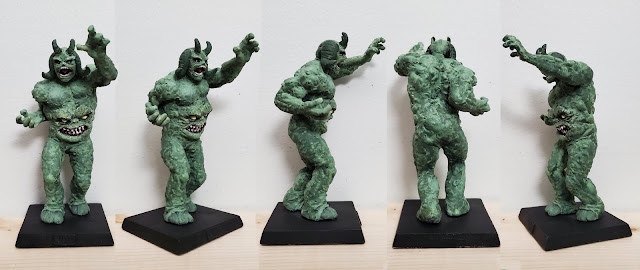As one of the most powerful demons in the Marvel Universe, Satannish rules over an other-dimensional netherworld where he draws energy from damned souls. Though not as well-known as his rival Mephisto, Satannish deserves a spot among the great supernatural villains in the Classic Marvel Figurine Collection.
First appearing in the pages of Dr. Strange #174 in 1968
(written by Roy Thomas and drawn by the Gene Colan) Satannish originally looked
nothing at all like the version we see today. Basically he was a generic
“devil” figure, with his features perpetually shrouded by flames (somewhat like
Dormammu, who was later revealed to have played a role in his creation). Sometimes he appeared solely as a gigantic red hand scooping up
unsuspecting souls.
 |
| Satannish's original form: flaming head and big red hand. |
1989 was a key year in the history of Satannish’s evolution
as a character. That year, two different writers showcased Satannish in
separate but concurrent story arcs, and each writer completely re-invented him
in their own way. In the pages of Incredible Hulk (starting with #356), Peter
David gave Satannish a human guise as mob boss Nicholas Cloot; when he finally
reveals his true form, he’s an enormous red devil, with horns and talons but
otherwise no distinctive features. (Peter David in fact used this version once more, years after Satannish's design had been changed -- perhaps he always intended it to be a separate character.)
 |
| Nicholas Cloot, demon mob boss |
 |
| Nicholas Cloot's true form? Or just another guise for Satannish? |
 |
| Classic Satannish arrives in 1989. |
Visually Jackson Guice’s Satannish was a pretty radical re-invention. With his bulky, green-skinned reptilian body, double horns, and of course, the demonic second face embedded in his belly, Satannish had finally found his definitive look. Jackson Guice was able to canonize his new version in late 1989 when he drew Satannish for the Official Handbook of the Marvel Universe Update 1989 series, and this has been his look ever since (with the single exception of Peter David’s second use of Cloot on the occasion mentioned above). Small details like the placement of his horns and the number of fingers tend to vary quite a bit from artist to artist, but Satannish is, after all, a demon, and in the final analysis he can adopt whatever appearance he wants to.
As these stories already have shown, Satannish’s
relationship with the other Hell Lords varies between cooperation and
competition. Satannish and Mephisto seem to have a particular hatred for one
another, battling on countless occasions over individual souls or
contested territory. Earth and its heroes tend to get caught in the middle of
these epic battles.
 |
| Satannish and Mephisto -- frenemies forever. |
On other occasions, though, the Hell Lords (nowadays
including Hela (ruler of the Asgardian underworld), Pluto (ruler of its Greek
equivalent) and occasionally others) work together to achieve common goals.
Perhaps surprisingly, Satannish in particular has a very staunch and unusual sense
of honor: when Pete Wisdom freed him from magical confinement, Satannish
reciprocated this favor by expelling all the invading Skrulls from the British
Isles.
 |
| The Council of Hell Lords -- business attire optional, flames mandatory |
 |
| Together with Dormammu. |
 |
| Sad-sack Satannish. |
To make Satannnish, I toyed with several possible base figurines before deciding on the Parasite figure from the DC chess collection. The chess figurines do not always scale perfectly with the original CMFC figurines, and also they are made of resin instead of lead, and so are considerably lighter. But on the other hand, I enjoyed the bumpy, pebbly texture of the Parasite figurine, as well as his monstrous, bulky demeanor and intimidating posture, all of which work perfectly for Satannish. I knew from the start he would be my first oversize "Special."
I did, however, end up cutting the figure into several parts
and straightening his overall posture, because otherwise the face in his belly
would not have been as visible. Sculpting the belly-face was quite tricky, as I
had to carve out a void in Parasite’s stomach and then carefully fill it with
teeth, and sculpt some ghoulish eyes and lips around it.
I like how the belly face turned out, but I’m less happy with the main face above—I had trouble converting Parasite’s features into Satannish and I never was able to get his horns exactly the way I wanted. Still, after painting him and mounting him on a Marvel base, I think he looks good enough to stand next to Mephisto, and raise hell among my Marvel Eaglemoss collection.
* ESSENTIAL READING *
1. Doctor Strange: Sorcerer Supreme #8 (Oct 1989). In the classic “Faust Gambit” story arc, Satannish feuds with Mephisto over the soul of Baron Mordo, with Earth as their battleground.
2. Avengers West Coast
#77 (Dec. 1991). In the first of several battles against the Avengers West
Coast, Satannish empowers a group of villains led by Hangman and threatens to
take over the planet.
3. Hellcat #2 (Oct
2000). When Dormammu attacks their realms, Satannish betrays his old enemy
Mephisto and reveals that he and Dormammu have a closer connection than anyone
suspected.
 |
| I hope you enjoyed your visit to Hell, human! |
Next up: Marvel's indestructible clown, Madcap!








Comments
Post a Comment